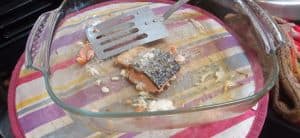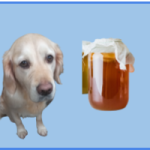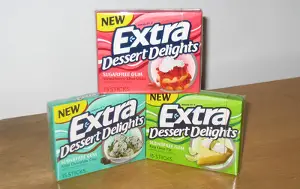
So there you are at the dining room table with everyone together- your husband and children and the family dog of course.
Just waiting to see if he will get any leftovers.
Perhaps tonight is the night- his lucky night.
After all, the family has just eaten some salmon fillets and some of the skin is left.
On the one hand it would be a shame to throw it all in the trash- it is a bit of a waste and it makes the bin stink!
And whilst you know that feeding your dog from the table will encourage him to beg even more, should dogs even be eating salmon skin?
That is what I hope to find out in this article.
So let me get straight to the point- is salmon skin poisonous to dogs?
Is Salmon skin poisonous to dogs?
Salmon like other fishes is a great protein source and so is its skin.
It’s a great addition to your dog’s meal as long as it is properly cooked.
But why does it need to be cooked properly?
Parasites and bacteria found in salmon
It is because salmon, like many fish, might contain a range of parasites and bacteria.
And the figures can be a bit scary.
This Canadian report suggests that up to 75% of wild Pacific salmon are infected with the herring worm parasite.
Whereas this report believes that there could be nearly a three hundred increase in parasites in raw fish since the 1970s.
And that’s the point.
Parasites and bacteria in salmon are only a threat to our health or our dog’s health if the fish is eaten raw- or it isn’t cooked properly.
If you want your skin to crawl a bit more I will briefly go over the bacteria that might be found in salmon.
These include salmonella, shigella and vibrio.
In a later section I will explain how you should safely cook salmon for your dog.
But for now I want to look at what some of the benefits are of feeding salmon skin to your dog.
Nutritional value of salmon skin
A quick root around in Google reveals that salmon skin seems to be a potential superfood for your dog.
It might have a huge impact across a range of health issues.
But, since I’m wary of keeping you for too long, I’m just going to look at the big stuff.
To start with a buzzword or buzz nutrient, salmon skin contains Omega acids.
I’m sure by now we have all heard of this phrase as it has been all over the media in recent years.
These acids help your dog with their vision and their brain function.
Next the skin contains oil which could potentially make your dog’s skin and coat glow- or shine at the very least.
And my final mention goes to the role that the oils have on a dog’s mobility as they should play a role of making their joints work better.
But it can all be good news is it?
No, it isn’t.
All that wonderful oil that we have just spoken so positively about does have a downside.
The fat and calorie count in salmon skin is off the scale.
Salmon skin is about 40% fat and a 100g serving can have as much as six hundred calories.
Now we need to put these claims into some sort of context.
Feeding your dog one piece of salmon skin isn’t going to get your dog a winner’s rosette at a local agility competition or to make him the most intelligent dog in the world.
Neither will it make your dog obese.
But, it does beg the question, how much salmon skin should you feed your dog?
Can I feed my dog salmon skin every day?
If at this stage of the article you are looking for a salmon skin calculator- an easy to use tool that after you have typed in your dog’s weight will spit out the ideal amount of salmon skin that your dog should be eating, then you are out of luck.
That calculator doesn’t exist on this page or any other.
Instead, I can only offer you some vague and general advice.
And that is to feed your dog salmon skin in moderation.
Perhaps skinnier dogs can have more than dogs which are on the larger size because of the calories.
The most logical thing to do would be to give them some salmon skin whenever you eat salmon.
For most of us, I’m guessing that is about once or twice a month.
And that frequency is adequate.
And only give them a small piece of skin.
About the size of a half a slice of bread is more than adequate.
What I’m saying is don’t be tempted to give your dog all of the skin from half a side of salmon that your whole family has just shared.
Throw the rest of it in the bin or cut it into portions, wrap the portions up and put them in the fridge.
Hand a sliver out every couple of days.
And now I want to compare the different ways that salmon skin can be prepared…
Fried vs grilled vs smoked salmon skin
Fried salmon skin prepared in too much oil is bad for your dog as it can cause pancreatitis.
On the other hand, smoked salmon might not be a very good option either as the smoking process might not eliminate all the parasites on the skin and some smoked fish skin might contain high levels of salt which is bad for your doggie.
The best form of cooked salmon skin to serve your dog is food cooked at 145°F as recommended by the United States Department of Agriculture (USDA), you can also serve your dog baked salmon skin, as always stay away from harmful ingredients.
Canned Salmon skin is also a good option for your dog all you have to check for is that it is water-based not oil or brine-based.
And now having looked at different ways to prepare salmon skin, I want to place salmon skin in another contest.
And in this one I look at how nutritious it is against other fish skins.
Salmon skin vs Sea bass skin vs Mackerel skin
So in this three way contest, who came out victorious?
Well to be honest, I drew a blank on this one.
There just isn’t the information on the nutrition of each of these fish skins.
And I have already outlined the data that I found for salmon skin.
I got as far as having it confirmed that skins from different fish do contain different nutrients but no further.
And giving it more thought, it soon becomes apparent that whereas taking the skin of a salmon or sea bass fillet might not be too difficult, stripping the skin from a mackerel would be a very difficult task.
In terms of the flesh of the fish, we do know that salmon is a better source of Omega 3 acids than mackerel.
And moving on, with my tail between my legs, I want to get quite deep and serious for a moment and talk about salmon poisoning.
Salmon poisoning in dogs
Now earlier I outlined how a dog that ate raw salmon might be susceptible to a few parasites and bacteria that might make them ill.
I mentioned the herring worm parasite and the bacteria salmonella.
These parasites and bacteria will not only make your dog ill but they could also make you ill.
But there is a separate disease specifically called salmon poisoning in dogs that some of you also need to be aware of.
Salmon poisoning in dogs is a serious illness that only affects dogs who eat raw salmon.
Now the good news is that this disease is only a real threat in the Pacific Northwest- and nowhere else in the world.
The bad news is that if it isn’t treated it might kill your dog.
Having dampened the mood a bit I want to begin to draw this article to a close by offering a few tips on how to safely cook salmon for your dog
How to safely cook salmon for a dog?
Perhaps, at this stage, I’m teaching grandma to suck eggs but there are some simple tips to help you prepare salmon correctly for your dog.
If you have a food thermometer then, when you poke it into the centre of the flesh, it needs to read 145°F.
Or if you want to do it visually then cook it until the salmon flesh is opaque.
And I don’t want to bore you with too much food safety advice but please remember that raw salmon is a danger before it is cooked because of its potential to contaminate other foods.
And to finish off I want to look at whether we should be feeding our dogs old salmon- and I don’t mean salmon that has lived a long life.
I mean salmon that we have kept in the back of the fridge for a few days longer than we should have.
Can I feed my dog old salmon?
You know what I mean.
Salmon that has been in the fridge for too long to feed to the family (well the human part of it) but you don’t want to waste it and dog’s can eat rotten food can’t they?
And perhaps by writing this I’m talking to a weird side of my personality that hates waste but is also cheap!
And the advice is simple- don’t be tempted.
Just wrap it up and throw it in the trash- the outside bins preferably unless you want a run in with your nearest and dearest about where that awful smell is coming from in the kitchen..
Just put the whole slightly expensive mistake down to experience and use the salmon much sooner next time.





